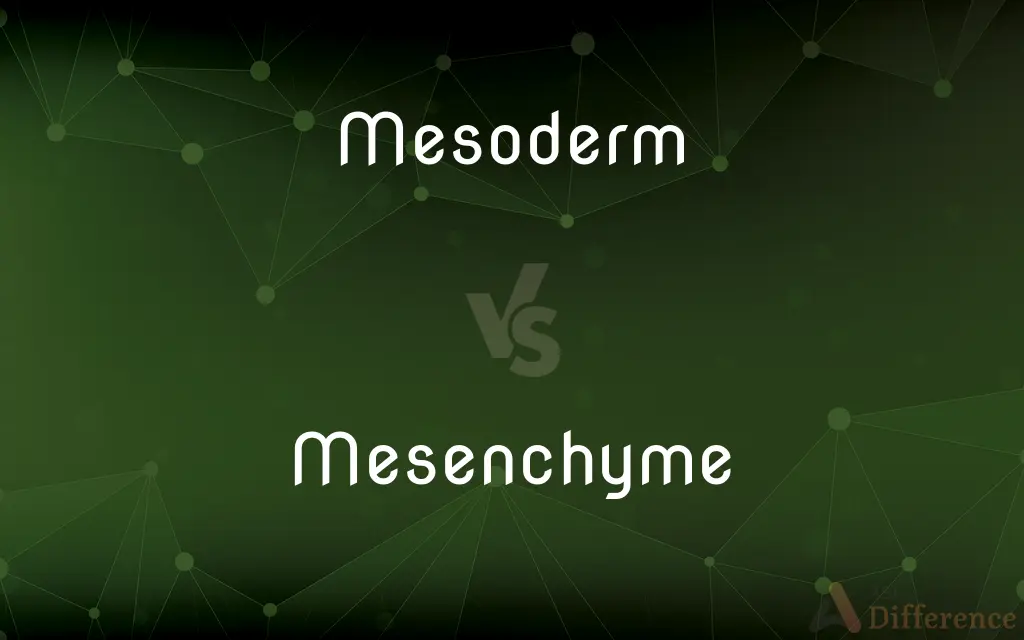Mesoderm vs. Mesenchyme — What's the Difference?
Edited by Tayyaba Rehman — By Fiza Rafique — Updated on October 5, 2023
Mesoderm is a primary germ layer in embryonic development, while mesenchyme is a type of tissue derived from mesoderm (and sometimes ectoderm) characterized by a loose, extracellular matrix and undifferentiated cells.

Difference Between Mesoderm and Mesenchyme
Table of Contents
ADVERTISEMENT
Key Differences
Mesoderm, in the realm of developmental biology, represents one of the three primary germ layers formed during the early stages of embryonic development. Mesenchyme, on the other hand, refers to a type of connective tissue that originates predominantly from the mesoderm. The differentiation of cells within the mesoderm layer gives rise to various tissues and organs, while mesenchyme serves as a kind of scaffolding, facilitating the formation of other tissues during development.
Both mesoderm and mesenchyme play crucial roles in embryogenesis, serving to differentiate and give rise to various tissue types and structures within the developing organism. The mesoderm ultimately forms muscles, bones, and the cardiovascular system, among other structures. Mesenchyme plays a slightly different role, acting to support and facilitate the development of other tissues, assisting in processes such as cell migration.
The mesoderm, once established in the embryonic structure, undergoes processes of differentiation and maturation to develop into various organ systems and tissue structures. Mesenchyme, in its functional role, often contributes to the formation of connective tissues, providing an interconnected network that allows other cells to migrate and establish further complex structures within the developing organism.
Mesoderm is inherently linked with mesenchyme, due to the latter originating from the former. The cellular differentiation that occurs within the mesoderm is fundamental to establishing the diverse array of cell types and tissues found within an organism. Mesenchyme, with its loose, fluid-like properties, plays a crucial role in guiding the formation and development of these structures, providing not only a physical substrate but also a range of growth factors and other signaling molecules.
In comparative terms, mesoderm functions as a foundational layer in embryonic development, contributing to the formation of numerous tissues and organs. Mesenchyme, while derived from mesoderm, contributes to the construction of tissues and organs by providing a malleable, supportive matrix that enables the movement and proliferation of cells, which is vital for the successful morphogenesis of the embryo.
ADVERTISEMENT
Comparison Chart
Definition
A primary germ layer in embryonic development.
Connective tissue, predominantly derived from mesoderm.
Role in Development
Differentiates into various tissues and organs.
Supports tissue development and cell migration.
Cellular Characteristics
Comprises specified, differentiated cells.
Contains loosely packed, undifferentiated cells.
Function
Forms muscles, bones, etc.
Forms the basis for connective tissues.
Derivation
Is an original germ layer in embryogenesis.
Derived mainly from mesoderm, sometimes ectoderm.
Compare with Definitions
Mesoderm
A primary layer in embryonic development contributing to multiple organ systems.
Several components of the urogenital system derive from the mesoderm.
Mesenchyme
A type of tissue facilitating the formation and development of organs.
Mesenchyme provides crucial support during the development of the pulmonary system.
Mesoderm
The layer responsible for developing into many organs and tissues.
The heart is one of the vital organs developed from the mesoderm.
Mesenchyme
An embryonic precursor to connective tissues in animals.
Connective tissues like tendons and ligaments originate from mesenchyme.
Mesoderm
The embryonic layer that originates skeletal, muscular, and circulatory systems.
The mesoderm plays a crucial role in establishing the vertebrate circulatory system.
Mesenchyme
Loosely arranged, unspecialized cells within an extracellular matrix.
Mesenchyme facilitates the migration of cells during embryonic development.
Mesoderm
A germ layer forming between the ectoderm and endoderm during embryogenesis.
The mesoderm gives rise to various tissues including muscle and bone.
Mesenchyme
A tissue type that assists in cell migration and tissue repair.
During injury repair, mesenchyme can play a role in facilitating tissue regeneration.
Mesoderm
The source of both somatic and splanchnic mesoderm layers in development.
The mesoderm differentiates to contribute to both body wall and gut wall structures.
Mesenchyme
A cellular network aiding in the distribution of nutrients and signaling molecules.
Mesenchyme supports developing tissues by distributing growth factors essential for development.
Mesoderm
In all bilaterian animals, the mesoderm is one of the three primary germ layers in the very early embryo. The other two layers are the ectoderm (outside layer) and endoderm (inside layer), with the mesoderm as the middle layer between them.The mesoderm forms mesenchyme, mesothelium, non-epithelial blood cells and coelomocytes.
Mesenchyme
Mesenchyme () is a type of loosely organised animal embryonic connective tissue of undifferentiated cells that gives rise to blood and lymph vessels, bone, and muscle.
Mesoderm
The middle embryonic germ layer, lying between the ectoderm and the endoderm, from which connective tissue, muscle, bone, and the urogenital and circulatory systems develop.
Mesenchyme
The part of the embryonic mesoderm, consisting of loosely packed, unspecialized cells set in a gelatinous ground substance, from which connective tissue, bone, cartilage, and the circulatory and lymphatic systems develop.
Mesoderm
(embryology) One of the three tissue layers in the embryo of a metazoan animal. Through embryonic development, it will produce many internal organs of the adult, e.g. muscles, spine and circulatory system.
Mesenchyme
(anatomy) That part of the mesoderm of an embryo that develops into connective tissue, bone, cartilage, etc
Mesoderm
The layer of the blastoderm, between the ectoderm and endoderm; mesoblast. See Illust. of Blastoderm and Ectoderm.
Mesenchyme
Mesodermal tissue that forms connective tissue and blood and smooth muscles
Mesoderm
The middle germ layer that develops into muscle and bone and cartilage and blood and connective tissue
Common Curiosities
Is mesenchyme a type of tissue or cell?
Mesenchyme refers to a type of tissue composed of loosely packed, undifferentiated cells within an extracellular matrix.
How does mesoderm contribute to muscle formation?
Mesoderm differentiates into myoblasts, which further develop into muscle tissue.
What role does mesenchyme play in development?
Mesenchyme facilitates tissue development by providing a supportive matrix and aiding cell migration.
What is mesoderm?
Mesoderm is one of the three primary germ layers formed during early embryonic development.
Can mesenchyme form skeletal tissue?
Yes, mesenchyme can differentiate into osteoblasts, contributing to bone formation.
What role does mesenchyme play in organogenesis?
Mesenchyme supports and guides the development and organization of cells during organ formation.
Does mesenchyme originate only from mesoderm?
Predominantly yes, though mesenchyme can also derive from ectoderm, such as in the case of neural crest cells.
What are the other germ layers aside from mesoderm?
The other two primary germ layers are ectoderm and endoderm.
Does mesoderm directly form organs?
Yes, mesoderm differentiates into various cells that contribute to the formation of organs like the heart and kidneys.
How is mesoderm related to the circulatory system?
Mesoderm gives rise to angioblasts, which develop into the cells that form the circulatory system.
Can mesenchyme differentiate into various cell types?
Yes, mesenchyme can differentiate into various cell types, particularly those found in connective tissues.
Is mesoderm present in all animals?
Mesoderm is present in triploblastic organisms, which includes most animal groups but not all.
Is mesoderm involved in skin formation?
Partially, mesoderm contributes to the dermis layer of the skin.
Can defects in mesoderm development affect the organism?
Yes, defects in mesoderm development can lead to various congenital abnormalities in the derived tissues and organs.
What factors influence mesenchyme function?
Various signaling molecules and transcription factors influence mesenchyme cell migration and differentiation.
Share Your Discovery

Previous Comparison
Bar vs. Beam
Next Comparison
Licensed vs. UnlicensedAuthor Spotlight
Written by
Fiza RafiqueFiza Rafique is a skilled content writer at AskDifference.com, where she meticulously refines and enhances written pieces. Drawing from her vast editorial expertise, Fiza ensures clarity, accuracy, and precision in every article. Passionate about language, she continually seeks to elevate the quality of content for readers worldwide.
Edited by
Tayyaba RehmanTayyaba Rehman is a distinguished writer, currently serving as a primary contributor to askdifference.com. As a researcher in semantics and etymology, Tayyaba's passion for the complexity of languages and their distinctions has found a perfect home on the platform. Tayyaba delves into the intricacies of language, distinguishing between commonly confused words and phrases, thereby providing clarity for readers worldwide.














































